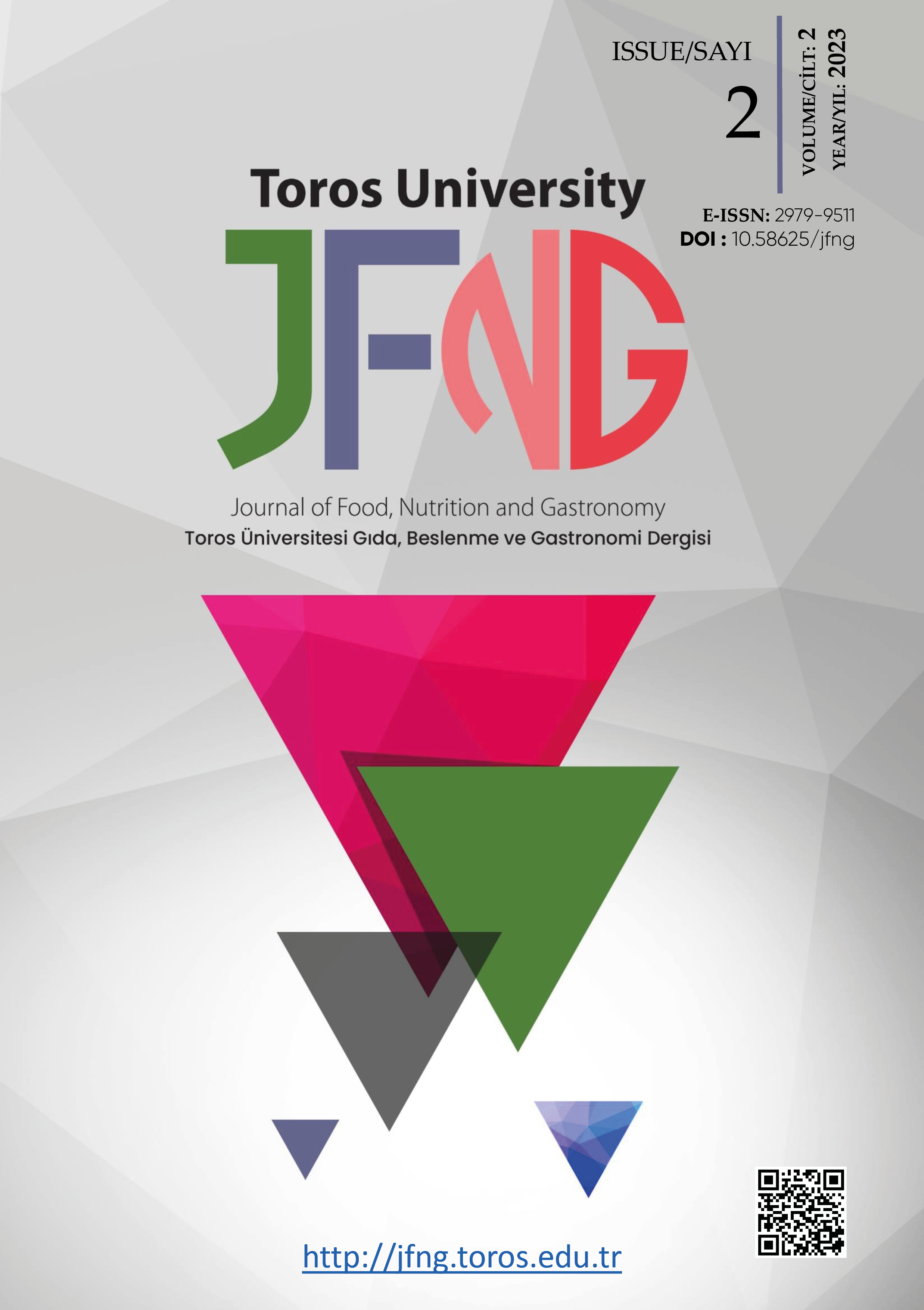Özet
Composite flours are recently manufactured not only to improve the desired functional properties of end products based on them but also to improve nutritional composition. This study is aimed at determining the physicochemical qualities and sensory properties of composite flour cookies. Germinated maize (Zea mays), Hildegardia barteri (“Kpaakpa”), and blanched plantain (Musa paradiciaca) flour were processed into flours and mixed into various blends using a mixture design. Cookies were produced from the composite flours using the creaming method. The physicochemical and organoleptic properties of the cookies were evaluated. The proximate results showed that increasing the level of Hildegardia barteri flour in the mixture enhanced the protein, fat, ash, and crude fiber contents of the cookies. Micronutrient results showed that iron and zinc increased with the high inclusion of Hildegardia barteri flour. The cookies’ physical properties did not significantly deviate from the control sample. The panelists’ mean score for overall acceptability ranged from 2.65 – 7.75 for all of the samples using HMP1 and HMP9 scoring the lowest. Most of the samples had sensory scores above the midpoints and were generally perceived as acceptable by the panelists. Cookies made with 33.3% of each component were most preferable as they were found to be the best in terms of overall quality. The results obtained from this study demonstrate the possible use of the Hildegardia barteri - based composite flours in bakery products up to 50 % level of substitution. This information can be used for designing food processing protocols which will target consumer requirements and overall acceptability.
Referanslar
Okpala, L. C & Okoli E. C. (2011). Nutritional evaluation of cookies produced from pigeon pea, cocoyam and sorghum flour blends. African Journal of Biotechnology, 3:433-438.http://www.academicjournals.org/AJB
Ubbor, S. C & Akobundu E. N. T. (2009), Quality characteristics of cookies from composite flour of watermelon seed, cassava and wheat. Pakistan Journal of Nutrition, 8(7):1095-1102.
Okaka, J. C. (1997). Cereals and legumes. Storage and processing technology. Data and Microsystems Publishers Enugu.
AOAC. 2015. Official methods of analysis. (20th Edn). Washington DC. Official methods of the Association of Official Analytical Chemists https://brooksapplied.com/wp-content/uploads/download/AOAC-Method-2015.01.pdf
James, C. J. (1995). The analytical chemistry of foods. Chapman and Hall Press, New York, Pp: 86. http://dx.doi.org/10.1007/978-1-4615-2165-5
Onuh, J. O., Akpapunam, M. A. & Iwe, M. O. (2004). Comparative studies of the physiochemical properties of two local varieties of sweet potato flours. Nigerian Food Journal. 22: 141-146. http://doi.org/ 10.4314/info.v22i1.33579
Chapman, H. N. & Pratt F. P. (1996). Determination of minerals by titration method. Method of analysis for soils, plants, and waters.2nd Edn. California University, Agriculture Division, USA Pp169-186.
AACC (2000). Approved methods of the American Association of Cereal Chemists (17th ed.). St Paul, MN. http://doi.org/10.4236/psych.2014.519216
Iwe, M. O. (2002).. Handbook of sensory methods and analysis. 1st Edn. Enugu: Rejoint communication Ltd. Pp.71.
Anyadioha, J. I., Okoli, E. C., Attaugwu, R.N & Ishiwu, C. N. (2017).The proximate and mineral composition of soaked and germinated kpaakpa (Hildegardia barteri) seed flour: A response surface methodology approach.International Journal of Food Science and Nutrition, 2 (5); 155-161.
Arise, A.K. Amonsou, E.O & Ijabadeniyi, O.A. (2015) Influence of extraction methods on functional properties of protein concentrates prepared from South African Bambara groundnut landraces. International Journal of Food Science and Technology, 50, 1095-1101.
FAO/WHO (1994). Joint FAO/WHO Food Standards program. Codex Alimentarius Commission, Foods for special dietary uses (including foods for infants and children). Vol. 4. http://doi.org/www.codexalimentarius.net
Ogunsina B.S., Olaoye I.O., Adegbenjo A.O. & Babawale B.D. (2011). Nutritional and physical properties of kariya seeds (Hidergardia bateri). International Agrophysics 25: 97-100.
SON (2007). Nigerian Industrial Standard for Biscuits. ICS: 664. 68, Standard Organization of Nigeria, Pp:1-8.
Okpala, L.C., Okoli, E.C. & Udensi E.(2013) Physicochemical and sensory properties of cookies made from blends of germinated pigeon pea, fermented sorghum, and cocoyam flours Food Science & Nutrition, 1(1):8-14. http://doi.org/10.1002/fsn3.2
Fattal-Valevski, A. (2011). Thiamin (vitamin B1). Journal of Evidence-Based Complement & Alternative Medicine, 16 (1): 12–20.
Zakpa, H. D. (2010). Production and characterization of flour produced from ripe "Apein" plantain (Musa Sapientum L.var.paradisiacal) grown in Ghana. Journal of Agricultural Biotechnology, (6):92-99.
Kaur, A. (2015). Biological functions of vitamin B complex and effects on human health in both excess and deficiency levels; PharmaTutor, 3(11); 40-47.
Institute of Medicine (1998). Standing Committee on the Scientific Evaluation of Dietary Reference Intakes and its Panel on folate, other B Vitamins, and choline. Washington (DC): National Academies Press (US); ISBN-10: 0-309-06411-2ISBN-13: http://doi.org/978-0-309-06411-8
Kashlan, N. B., Srivastava, V. P., Muohanna, N. A., Motawa, Y. K. & Mameesh, M. S. (1991). The proximate and elemental composition of wheat flour and major types of bread consumed in Kuwait. Journal of Food Chemistry, 39 (2):205-210.
Khan, M. S., Zaman, S, Sajjad, M., Shoaib M. & Gilani, G. (2011). Assessment of the level of trace element zinc in seminal plasma of males and evaluation of its role in male infertility. International Journal of Applied Basic Medical Research, (2):93–6.
Prasad, A. S. (2013). Discovery of human zinc deficiency: its impact on human health and disease. Advances in Nutrition, 4(2):176–90.
Bala, A, Khalid, G, & Charanjit, S. R. (2015). Functional and sensory properties of cookies prepared from wheat flour supplemented with cassava and water chestnut flours, Cogent foods & Agriculture, 1:1, 1019815. http://doi.org/ 10.1080/23311932.2015.1019815
Chauhan, A., Sexana, D. C., Yildiz, F and Singh, S. (2016). Physical, textural, and sensory characteristics of wheat and amaranth flour blend cookies. Cogent Food And Agriculture, 2(1):1125773 http://doi.org/10.1080/23311932.2015.1125773
Jean-Xavier, G. & Rossella, M. (1996): The sensory perception of texture and mouth
feel. Trends in Food Science & Technology, (7): 213-219. http://doi.org/10.4038/sljfa.v1i2.16
Jemziya, M. B. F. & Mahendran, T. (2015). Quality characteristics and sensory evaluation of cookies produced from composite blends of sweet potato (Ipomoea batatas L.) and wheat (Triticum aestivum L.) flour. Sri Lanka Journal of Food & Agriculture, 1(2): 23-30. http://doi.org/10.4038/sijfa.v1i2.6

Bu çalışma Creative Commons Attribution 4.0 International License ile lisanslanmıştır.
Telif Hakkı (c) 2024 Toros Üniversitesi Gıda, Beslenme ve Gastronomi Dergisi






